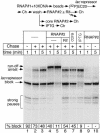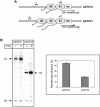Transcription through the roadblocks: the role of RNA polymerase cooperation
- PMID: 12970184
- PMCID: PMC212720
- DOI: 10.1093/emboj/cdg452
Transcription through the roadblocks: the role of RNA polymerase cooperation
Abstract
During transcription, cellular RNA polymerases (RNAP) have to deal with numerous potential roadblocks imposed by various DNA binding proteins. Many such proteins partially or completely interrupt a single round of RNA chain elongation in vitro. Here we demonstrate that Escherichia coli RNAP can effectively read through the site-specific DNA-binding proteins in vitro and in vivo if more than one RNAP molecule is allowed to initiate from the same promoter. The anti-roadblock activity of the trailing RNAP does not require transcript cleavage activity but relies on forward translocation of roadblocked complexes. These results support a cooperation model of transcription whereby RNAP molecules behave as 'partners' helping one another to traverse intrinsic and extrinsic obstacles.
Figures






References
-
- Aso T., Lane,W.S., Conaway,J.W. and Conaway,R.C. (1995) Elongin (SIII): a multisubunit regulator of elongation by RNA polymerase II. Science, 269, 1439–1443. - PubMed
-
- Bardeleben C., Kassavetis,G.A. and Geiduschek,E.P. (1994) Encounters of Saccharomyces cerevisiae RNA polymerase III with its transcription factors during RNA chain elongation. J. Mol. Biol., 235, 1193–1205. - PubMed
-
- Barkley M.D. (1981) Salt dependence of the kinetics of the lac repressor–operator interaction: role of nonoperator deoxyribonucleic acid in the association reaction. Biochemistry, 20, 3833–3842. - PubMed
-
- Bateman E. and Paule,M.R. (1988) Promoter occlusion during ribosomal RNA transcription. Cell, 54, 985–992. - PubMed
Publication types
MeSH terms
Substances
Grants and funding
LinkOut - more resources
Full Text Sources
Other Literature Sources
Molecular Biology Databases

